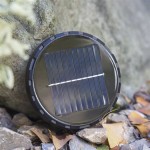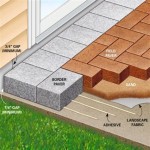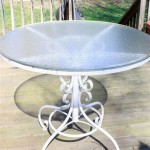How To Clean Stained Cement Patio
A cement patio provides a versatile and durable outdoor space for recreation, relaxation, and entertainment. Over time, however, exposure to the elements, spills, and general use can lead to unsightly stains that detract from its aesthetic appeal. Effective cleaning can restore the patio's original appearance and extend its lifespan. This article provides a comprehensive guide to cleaning stained cement patios, covering various stain types and appropriate cleaning methods.
Identifying the Stain
Before commencing any cleaning procedure, identifying the nature of the stain is crucial. Different types of stains require different treatments. Common culprits include organic stains (leaves, mildew, algae), oil-based stains (grease, motor oil), rust stains, and efflorescence (white, powdery salt deposits). A visual inspection, combined with knowledge of the patio's history of use, will often reveal the source of the stain.
Organic Stains: These stains are typically characterized by discoloration in shades of brown, green, or black. They are caused by the decomposition of organic matter, such as leaves, grass clippings, and food spills. Mildew and algae, thriving in damp environments, also contribute to organic staining.
Oil-Based Stains: Grease, motor oil, cooking oil, and other petroleum-based products can penetrate the porous surface of cement, leaving dark, persistent stains. These stains are often identified by their greasy or oily appearance and tendency to attract dirt and debris.
Rust Stains: Rust stains are typically reddish-brown or orange in color and are caused by the oxidation of iron. They can result from metal objects left on the patio surface, such as furniture legs, tools, or fertilizer containing iron.
Efflorescence: This white, powdery substance is caused by the migration of soluble salts to the surface of the cement. As water evaporates, it leaves behind salt deposits. While not strictly a stain, efflorescence can be unsightly and indicate underlying moisture problems.
The identification of the stain dictates the selection of the appropriate cleaning solution and method. Using the wrong cleaning agent can be ineffective and potentially damage the cement surface.
Preparation and Safety Measures
Prior to cleaning, the patio area necessitates thorough preparation. This involves removing all furniture, planters, and other objects from the surface. Sweeping or blowing away loose dirt, debris, and leaves is essential to ensure the cleaning solution comes into direct contact with the stains.
Safety is paramount when working with cleaning chemicals. Always wear appropriate personal protective equipment (PPE), including gloves, eye protection (safety glasses or goggles), and a mask or respirator, especially when using strong chemicals or working in enclosed spaces. Proper ventilation is also crucial to avoid inhaling fumes. Refer to the manufacturer's instructions and safety data sheets (SDS) for specific safety precautions related to the chosen cleaning product.
Before applying any cleaning solution to the entire patio, test it on a small, inconspicuous area to ensure it does not discolor or damage the cement. This step is particularly important when using strong chemicals or when dealing with older or more delicate cement surfaces.
Protecting surrounding landscaping is also vital. Cover any plants or shrubs near the patio with plastic sheeting or tarps to prevent damage from cleaning solutions. Rinse any areas that inadvertently come into contact with the cleaning agent immediately with copious amounts of water.
Cleaning Methods for Different Stain Types
The method employed for cleaning a stained cement patio depends largely on the type of stain present. Below are specific approaches for addressing common stain categories.
Cleaning Organic Stains: For organic stains, a solution of mild detergent and water is frequently sufficient. Mix a small amount of dish soap or laundry detergent with warm water and apply it to the stained area. Scrub the surface with a stiff-bristled brush, working the solution into the stain. Rinse thoroughly with clean water. For more persistent organic stains, consider using a pressure washer on a low setting, taking care not to damage the cement surface. Oxygen bleach (sodium percarbonate) can also be effective for removing organic stains. Mix the oxygen bleach with water according to the manufacturer's instructions, apply it to the stained area, and let it sit for the recommended time before scrubbing and rinsing.
Cleaning Oil-Based Stains: Oil-based stains require a different approach due to their tendency to penetrate the cement. One effective method involves using a degreaser specifically designed for concrete. Apply the degreaser to the stained area and allow it to dwell for the recommended time. Scrub vigorously with a stiff-bristled brush and rinse thoroughly with clean water. For older, more stubborn oil stains, consider using a poultice. A poultice is a paste-like mixture that draws the stain out of the cement. Common poultice ingredients include baking soda, diatomaceous earth, or kitty litter mixed with a solvent such as acetone or mineral spirits. Apply the poultice to the stained area, cover it with plastic wrap, and let it sit for 24-48 hours. Remove the poultice and scrub the area with a brush and detergent solution before rinsing.
Cleaning Rust Stains: Rust stains can be challenging to remove, but several effective methods are available. One option is to use a commercial rust remover specifically formulated for concrete. Follow the manufacturer's instructions carefully, as these products can be corrosive. Another approach involves using a mixture of lemon juice and salt. Apply the mixture to the rust stain, let it sit for several minutes, and then scrub with a brush. Rinse thoroughly with water. Oxalic acid is also effective for removing rust stains. Dissolve oxalic acid crystals in water according to the manufacturer's instructions and apply the solution to the stained area. Let it sit for the recommended time before scrubbing and rinsing. Exercise caution when using oxalic acid, as it is a toxic substance. Always wear appropriate PPE and follow the safety precautions outlined on the product label.
Cleaning Efflorescence: Efflorescence is typically removed with a stiff-bristled brush and water. In many cases, simple scrubbing is sufficient to remove the white, powdery deposits. For more stubborn efflorescence, a mild acidic solution, such as diluted vinegar or muriatic acid, can be used. However, exercise extreme caution when using muriatic acid, as it is a strong corrosive. Always wear appropriate PPE, dilute the acid according to the manufacturer's instructions, and test it on a small, inconspicuous area before applying it to the entire patio. Neutralize the acid with a solution of baking soda and water after cleaning and rinse thoroughly with clean water.
In situations where stains persist despite repeated cleaning efforts, professional cleaning services specializing in concrete restoration may be necessary. These services have access to specialized equipment and chemicals that can effectively remove even the most stubborn stains while minimizing the risk of damage to the cement surface.
Preventative Measures
Preventing stains is preferential to treating them. Implementing preventative measures can significantly reduce the need for frequent and aggressive cleaning.
Sealing the cement patio is a highly effective way to protect it from stains. A sealant creates a barrier that prevents liquids and other substances from penetrating the surface. Choose a sealant specifically designed for concrete and follow the manufacturer's instructions for application. Reapply the sealant every few years, or as needed, to maintain its protective properties.
Promptly cleaning up spills is crucial to prevent stains from setting in. Wipe up any spills immediately with a cloth or paper towel. For oil-based spills, use an absorbent material, such as kitty litter or sawdust, to soak up the excess liquid before cleaning the area with a degreaser.
Using mats or rugs in high-traffic areas can help protect the patio surface from dirt and stains. Place mats at entryways and under furniture to prevent dirt and debris from being tracked onto the patio and to protect the cement from scratches and scuffs.
Regular sweeping or blowing of the patio surface is essential to remove leaves, dirt, and other debris that can contribute to staining. This simple task can help prevent organic stains and keep the patio looking its best.
Positioning potted plants strategically can further minimize staining. Use saucers under potted plants to catch excess water and prevent it from staining the patio surface. Consider using plant stands to elevate the pots and allow for better airflow, which can help prevent the growth of mildew and algae.
Proper drainage is crucial for preventing moisture-related issues, such as efflorescence and mildew growth. Ensure that the patio is properly sloped to allow water to drain away from the surface. Address any drainage problems promptly to prevent water from pooling and causing stains.
By implementing these preventative measures, the need for aggressive cleaning will be minimized, extending the lifespan and maintaining the aesthetic appeal of the cement patio.
By understanding different stain types, safely employing appropriate cleaning methods, and implementing preventative strategies, maintaining a clean and attractive cement patio is achievable. Regular maintenance and prompt attention to spills will contribute significantly to preserving the patio's integrity and enjoyment for years to come.

Best Way To Clean A Concrete Patio Chalking Up Success

How To Clean Concrete The Easy Way Porches Patios Driveways More Run Radiance

Diy Miracle Concrete Patio Cleaner I Should Be Mopping The Floor

How To Clean Concrete The Easy Way Porches Patios Driveways More Run Radiance

Diy Miracle Concrete Patio Cleaner I Should Be Mopping The Floor

6 Easy Ways To Clean Your Concrete Patio For Spring

How To Clean A Concrete Patio Maintenance Tips Network

Conquer Concrete Stains Once And For All With Wet Forget Outdoor Life S Dirty Clean Easy

How To Remove Grease Stains From Concrete Prosoco

How To Remove Concrete Stains Oil Paint Rust More Bob Vila
See Also








